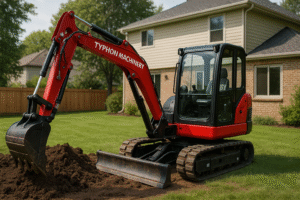In the fields of gardening and building, the correct equipment can make all the difference. Now let me introduce a little but powerful tool that has proven important in many different fields: the tiny excavator. Whether your work is landscaping, building, or do-it-yourself, knowing the nuances of micro excavators will help your projects reach unprecedented quality.
Getting to Know Mini Excavators
Often referred to as mini excavators or “compact excavators,” these are smaller variants of the conventional excavator. Considered to weigh one to 10 tons, these devices are prized for their adaptability and efficiency. Mini excavators’ small scale allows them to do jobs in confined areas where bigger equipment would find it difficult. Their purposes are many and varied, from demolishing little buildings to trench digging.
Mini excavators differentiate themselves by their capacity to easily handle a broad spectrum of jobs. Construction experts love them since they include characteristics like 360-degree rotation and fast-switching attachments that can be replaced. Their adaptability lets workers change from digging to grading in a few short minutes.
Mini excavators are revolutionary for anyone working in landscaping. They preserve the integrity of current landscapes while adding new elements, therefore enabling accurate work in delicate surroundings. These machines gracefully manage everything, including building a pond and laying down paving stones.
What Can You Do With a Mini Excavator?
Because of their adaptability and capacity to run effectively in confined areas and on uneven ground, mini excavators are a great help to building enterprises. From transporting materials to excavating foundations, these small powerhouses can help with a variety of chores vital for any building job. For some scenarios on the job site, their simplicity of use and range of handy attachments make them the best option.
Among the most effective attachments for construction work are:
- Rippers: Designed to cut through strong, compacted earth and ice, rippers create the necessary space for construction operations to proceed smoothly.
- Augers: These are essential for drilling into the ground, allowing for the installation of fences, support posts, and other structural components with precision.
- Compactors: Available in various shapes and sizes, including plates and rollers, compactors are critical for clearing and leveling surfaces, ensuring foundational integrity for forthcoming construction activities.
Incorporating these attachments enhances the capabilities of mini excavators, making them indispensable in any modern construction toolkit.
Enhancing Farming and Landscaping with Mini Excavators
Apart from their use on building sites, mini excavators are quite important in farming and landscaping. On farms, they simplify many chores, including digging holes, building fences, and carrying hay bales. Mini excavators are very useful for agricultural activities since they may make use of the same attachments beneficial for construction, therefore enhancing their adaptability. Moreover, they can plow the ground and quickly raise large objects, like animal feed and compost, improving the efficiency and simplicity of agricultural operations.
Mini excavators are especially helpful in landscaping since they are light-weight and small. They minimize damage to the grass and ground by negotiating lawns with ease. Different attachments improve its usefulness for certain jobs, including clearing trash, bringing in landscaping materials, planting and tree removal, and even pool building. Mini excavators also help with lawn care and maintenance by allowing mulching and the demolition of buildings like sheds, decks, and old fences. Mini excavators are a basic tool for both landscapers and farmers because of their several uses.
Handling Materials
A mini excavator is a necessary instrument for efficient material handling in many different sectors, including lifting and pushing objects. These machines’ strength and durability allow them to effectively and safely move or clear a variety of materials—from compacted soil and waste to irregularly shaped loads. Their small size lets operators easily negotiate limited workspaces, which makes them essential in situations where bigger equipment would be unworkable. Using a tiny excavator, jobs like clearing building sites or transferring large aggregates become simplified procedures that greatly increase output.
Maintenance
Practically and financially, a mini excavator is the best answer for maintenance and utility jobs. Usually less expensive than their larger counterparts, these machines still have the capacity to do a wide spectrum of basic chores. Mini excavators shine in maintaining efficiency and effectiveness, whether it’s excavating trenches for sewer lines, getting sites ready for utility pole installations, doing cleanup, or even snow and road removal. Any fleet would be wise to invest in them since their adaptability not only increases production but also helps to lower running expenses.
Why Choose Mini Excavators?
Mini excavators have mostly one benefit: their economy of expense. On fuel, maintenance, and transportation, they provide notable savings over more massive devices. Their smaller footprint indicates they run on less gasoline, which results in cheaper running expenses. These savings can be quite significant for small business owners or individual contractors.
Another important advantage is maneuverability. Mini excavators can readily reach tight corners and small areas that bigger equipment cannot access. They are therefore perfect for urban projects with limited space since this Their capacity to turn on the spot guarantees operators’ efficiency, free from continual repositioning.
One cannot really overestimate the adaptability of small excavators. These machines can easily tackle a variety of jobs with their range of attachments—buckles, hammers, and augers. Their versatility makes them a great help on every construction site, therefore lowering the demand for several pieces of equipment.
Exploring the Types of Mini Excavators
Different project requirements call for different kinds of mini-excavators. Perfect for interior or backyard projects, the smallest—known as mini excavators—weigh less than two tons. Their small footprint lets them pass through conventional doors, giving flexibility for garden or interior demolition.
Between two and six tons, compact excavators blend size with power. Small to medium-sized building projects would find them perfect since they provide the muscle required without compromising mobility. Both home and business tasks find great favor with this equipment.
On the higher end of the spectrum, medium excavators weigh six to 10 tons. Though still considered small excavators, they provide more power for more difficult jobs. Ideal for moderate construction jobs or bigger landscaping projects, they offer the strength required while preserving the benefits of small equipment.
Selecting the Perfect Mini Excavator
Selecting the appropriate mini excavator calls for several important factors. Review first the particular needs of your project. Think about the depth and width of trenches you must excavate, the kind of materials you will be working with, and the area free for machine maneuverability.
Another vital consideration is terrain. Choose a compact excavator with exceptional stability and traction if your project calls for traversing hills or uneven ground. Some types fit delicate settings since they include rubber treads that reduce ground disturbance.
Of course, the decision-making process is greatly influenced by budget. Although new mini excavators have warranties and modern conveniences, buying used equipment can be rather reasonably priced. Examine your long-term requirements and select a model that fits your budget.
Mastering the Art of Mini Excavator Operation
Using a mini excavator effectively and safely calls for following top standards. Operators should thoroughly check the machine to find any indications of wear or damage before starting any operation. Ensuring the lifetime of the equipment depends mostly on regular maintenance.
Safety should always come first. Operators should wear suitable protective gear, including helmets and high-visibility vests; they must also be taught to utilize the controls effectively. Knowing the capacity and restrictions of the machine helps one avoid mishaps and harm to the worksite.
On the job site, good communication is absolutely vital. By coordinating with ground staff, operators should make sure everyone is aware of the machine’s movements. By means of this cooperative approach, hazards are reduced, and a safe workplace for all engaged is promoted.
Essential Maintenance Tips for Longevity
Mini excavators must be kept in the best shape through proper maintenance. Check hydraulic fluid, coolant, and engine oil, among other fluid levels, regularly. Maintaining these at the advised levels guarantees flawless performance and helps to avoid overheating.
Look for damage or wear on the wheels or rails. Quick replacement of worn-out parts saves more damage and improves machine stability. Also, routinely clean the undercarriage to clear trash that could compromise performance.
An additional crucial component of maintenance is greasing moving components. This lessens friction and stops early part wear-through. Using the manufacturer’s maintenance schedule and recommendations guarantees that your mini excavator stays dependable and effective.
Real-Life Success Stories with Mini Excavators
Many great undertakings in many different sectors have greatly benefited from mini excavators. In building, they have allowed the accomplishment of difficult tasks with limited space, therefore improving processes and client satisfaction.
By precisely designing complex gardens, landscapers have profited from these machines. Mini excavators are quite helpful in changing environments since they allow one to do delicate jobs without harming the surroundings.
Mini excavators have enabled ambitious ideas for do-it-yourselfers to come to pass. From laying swimming pools to creating terraces, these devices have enabled people to handle significant jobs on their own.
The Future of Mini Excavators
Mini excavators have a promising future since technological developments open even more possibilities. With self-operating equipment now here, automation is poised to transform the sector. This will improve accuracy and help to lower the requirement for human involvement.
Energy efficiency innovations also seem just around the corner. To lessen the environmental impact of building operations, manufacturers are looking at alternate power sources, including hybrid and electric engines. This change fits the increasing need for environmentally friendly living.
Moreover, smart technology will let operators remotely monitor and manage machines. Real-time performance and diagnostics data will simplify maintenance and raise general efficiency, hence defining new industry benchmarks.
How Much Can a Mini Excavator Lift?
For their relative weight, mini excavators—usually weighing between 1,000 and 1,500 pounds on average—can lift a significant amount. Larger models can, however, manage loads greater than 10,000 pounds. Several elements should be taken into account while deciding the lifting capacity required for your project: the size of the excavator, the particular application, and the job site conditions; they will eventually affect the pricing and fitability of the machine.
Several key elements affect the lifting capacity of a mini excavator:
- Counterweight: This feature is essential for maintaining balance when lifting heavy loads. A well-designed counterweight prevents the machine from tipping and enhances safety during operation.
- Attachment: Different attachments possess varying weight capacities. Choosing the correct attachment tailored for heavier loads can significantly improve efficiency and operational effectiveness.
- Hydraulic System: The hydraulic system is the powerhouse of the excavator, driving the arm’s and bucket’s movements. Its strength directly impacts the overall weight capacity that the machine can handle.
- Ground Conditions: The type of terrain where the excavator operates can greatly influence its lifting capability. Soft, wet, or uneven ground can diminish stability and lifting strength, necessitating careful evaluations and possibly additional support mechanisms to achieve optimal performance.
Wrapping Up with Actionable Insights
Mini excavators, then, are evidence of the ability of little machinery to revolutionize sectors. For professionals in construction, landscapers, and do-it-yourselfers equally, their adaptability, simplicity, and efficiency make them an important tool.
Understanding the several kinds, running guidelines, and maintenance needs of mini excavators can help you make wise judgments, improving the success of your projects. Now is the ideal moment to investigate the possibilities of small excavators in your projects, since technological developments promise an interesting future.
Go one step farther and really become engrossed in the realm of little excavators. Discover the countless opportunities they present, and use their great power and accuracy to improve your work.
Contact TYPHON Machinery for Mini Excavators
Our staff is ready to help you discover the outstanding array of mini excavators that TYPHON Machinery offers. We are available to help you with inquiries regarding certain models, advice on the appropriate tools for your project, or discussion of financing possibilities.
To get in touch, please reach out via our website or contact us directly at support@typhonmachinery.com, +1 424 653 6764 . Our knowledgeable staff is dedicated to providing you with the information and support necessary to ensure you make the best choice for your needs. Let’s elevate your projects together with the power of TYPHON Machinery’s mini excavators!





